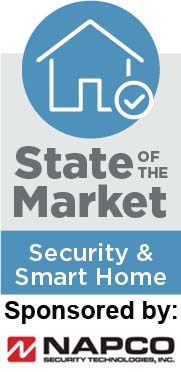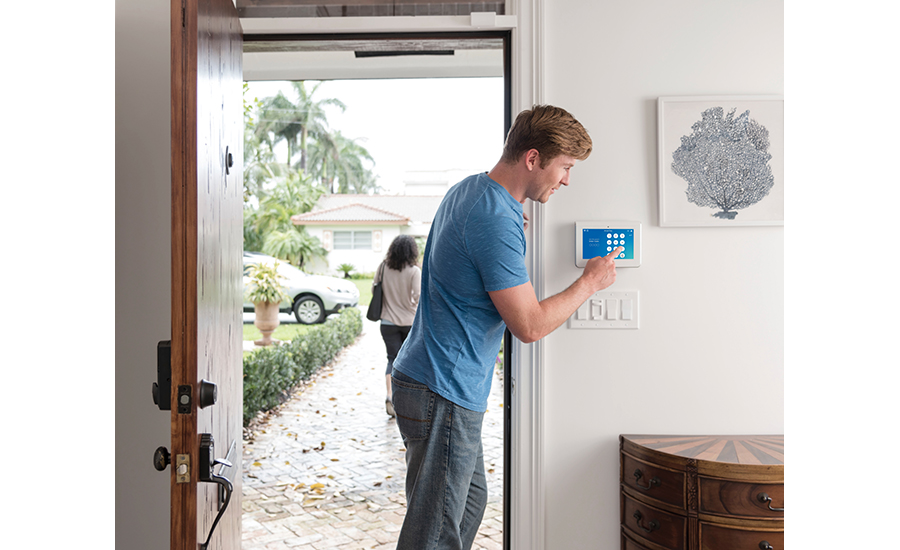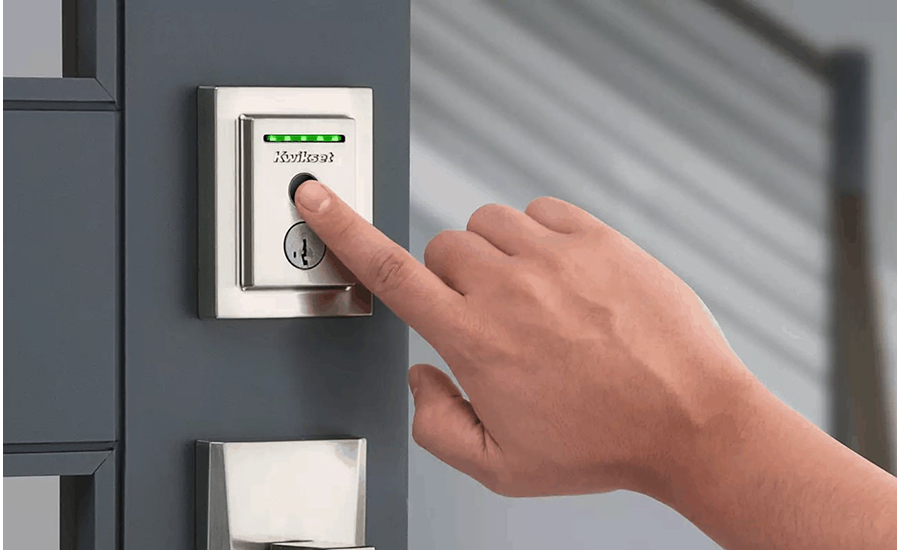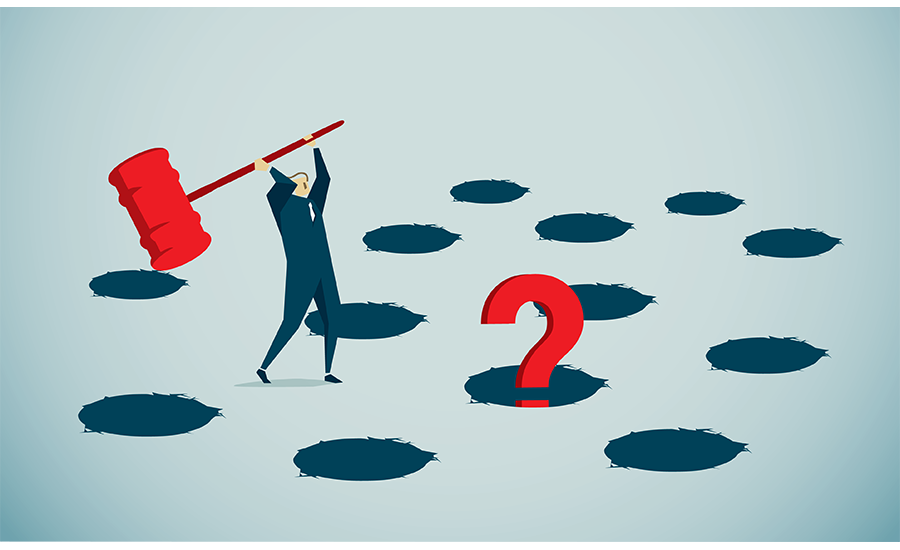The cloud, AI, more IoT devices, and simple phone apps make it possible for residents to increase security and control many basic home functions — from unlocking doors to watching pets and children to tracking energy use. And smart home product manufacturers are introducing new conveniences every day, smartening up everything from doorbells to garage door openers. Throw a pandemic into the mix, which forced people to do everything from their homes, and the result is big growth in the home security/smart home market: from 28 percent adoption in U.S. broadband households in Q2 2019, to 35 percent in Q4 2021, according to Parks Associates.
“Automation makes life easier by streamlining multiple smart devices through one app, allowing different devices to work together, delivering highly personalized scenes and experiences for home and business owners,” says Anne Ferguson, vice president of marketing for Alarm.com, Tysons, Va. “End users can control everything with one unified platform: their security system, locks, lights, video, thermostat, cameras, garage door, solar, energy, water, audio, and connected car.”
It’s all good news for security dealers and manufacturers, who stand to gain from this boom. According to SDM’s 2022 Forecast, four in five respondents that do residential work reported sales of residential security systems in the past 12 months, with the median sales price of a single-family home security system being $1,200 during that time. And while 48 percent of survey respondents said they offered smart home/home entertainment systems, another 19 percent said they planned to offer, sell, or install them over the next one to five years. What’s more, 75 percent of respondents described the smart home space as “good” or “excellent.”
The intrusion and monitoring segments are robust as well, with 83 percent describing that market as good or excellent, up 12 percentage points from the previous year. Seventy-five percent of 2022 Industry Forecast respondents providing burglar alarm services, and 74 percent providing monitoring via internet, RF, cellular, or digital cloud/remote only.
“Our expectations in 2022 are high due to the sheer amount of consumer interest generated by smart home technology,” says Christian Hess, co-founder and managing partner of Guardian Systems, Smyrna, Tenn. (featured on this month’s cover) “The world’s biggest tech companies and innovators have entered a race to one-up each other in the IoT technology space, meaning bigger, better smart home tech is constantly being tested and developed to match our digital needs. The industry is on a tremendous upward trajectory, and the ‘sky is the limit’ attitude will also help drive the technology even further in the coming years.”
Security Professionals’ Perception of the Intrusion Alarm Market
SDM asked, “How would you rate the current state of the market and the potential for sales in the intrusion (burglar) alarm market?”
When asked about the current state of the burglar alarm market, 46 percent thought it was good or excellent, up 12 percentage points from the previous year. SOURCE: SDM 2021 AND 2022 INDUSTRY FORECAST STUDIES
Although COVID-19 definitely gave the smart home segment the proverbial shot in the arm, the market has been growing since 2018, when product innovations, new entrants, and diversifying business models began giving consumers more choice, says Ryan Hulla, research analyst at Parks Associates, Addison, Texas. Much of this was in the DIY category, with companies like Simplisafe, Cove, and others leading the charge.
Then came the pandemic, and in 2020, quarantines that made people acutely aware of the need to make their homes as comfortable, efficient, and secure as possible. People who were living, working, attending school, and socializing online within those four walls looked around their homes and determined where they needed to make improvements — including adding or enhancing security or smart home systems.
“The residential market for smart home security grew faster in 2020-2021 than it had in years,” Ferguson says. “Now, with more people returning to the office, there is an increased interest in home security to help monitor and protect families and pets.”
During the quarantine, security dealers were designated as “essential workers,” and while there were some customer concerns about allowing installers into their homes during the worst of COVID-19, the market rebounded quickly. “We were preparing ourselves for the, ‘Since I’m now working from home I don’t need a security system’ excuses, but in fact, the exact opposite occurred,” says Jeremy McLerran, senior director of global marketing at Johnson Controls, San Jose, Calif. “People called their dealers and said, ‘I’m home all the time and I’m realizing how archaic my security system is. I’m ready for an upgrade!’ Add to that the political unrest that occurred across the nation and the 3G sunset, and we saw demand not just maintain, but increase.”
The Smart Home Push
Coronavirus made more people aware of the need for smart home capabilities, especially in the hybrid/work-from-home space, says Akash Sah, chief strategy officer at Brinks Home, Dallas. “Home automation can make it easier to watch the kids or your dog in the backyard, change the temperature of the home, control access through smart locks, etc. We’ve seen more and more customers asking us to provide a true, whole home solution as a result of the pandemic, and our expectation is for that trend to continue.”
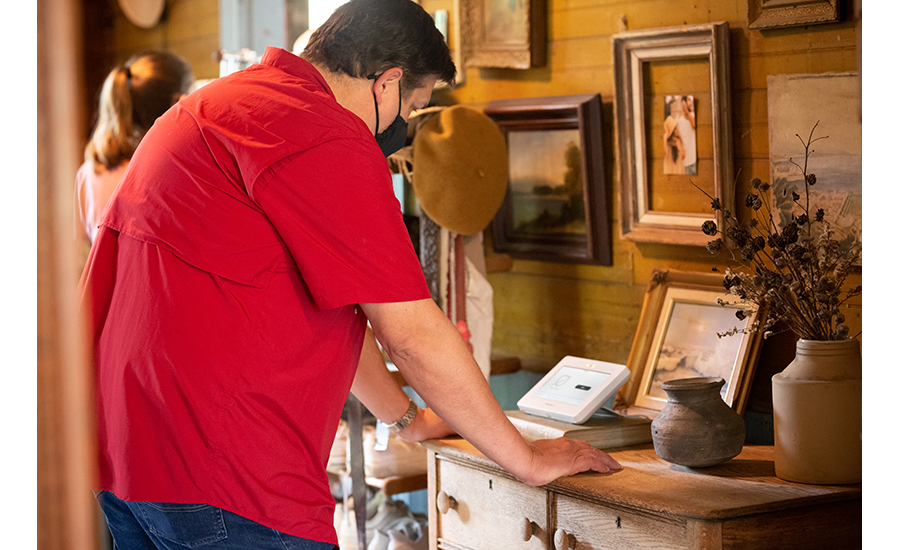
While some customers were concerned about installers in their homes at the beginning of COVID-19, the market rebounded quickly. // IMAGE COURTESY OF RESIDEO
This connectivity played an important role for people to stay close to loved ones during the pandemic. For example, families used Alarm.com’s Wellness and Wellcam products, designed as independent living technology, to stay in touch with loved ones in nursing homes during the pandemic. Medical staff at hospitals used the Wellcam in rooms to check on patients and maintain communication, Ferguson says.
And while the world may be opening up again, that focus on home security and convenience generated during the pandemic isn’t going away; in fact, it may be intensifying, especially with hybrid work and school arrangements. “Schedules are odd now; the straight eight-hours-a-day workplace is gone,” says Nick English, national sales director for Kwikset, Lake Forest, Calif. “Sometimes people are working only two days at the office, and kids are in school full or part time. Total home management becomes even more important, and that’s where automation and door lock control comes in.”
The biggest impact on growth in the smart home market will come from the transition from a primarily in-office workplace to a hybrid situation where more companies offer the flexibility to work from home or the office based upon need, says Tom Mechler, regional marketing manager North America, intrusion products for Bosch Security and Safety Systems, Fairport, N.Y.
More leisure travel in the wake of the pandemic is also making customers more aware of the need for smart security. “Coming out of the COVID-19 pandemic, consumers are beginning to travel again, which will increase the demand for devices that provide safety, protection, and 24/7 monitoring of the home,” says Mitchell Klein, executive director of Z-Wave Alliance and director, Alliances Strategy, Silicon Labs, Las Vegas. “Add-on sales of devices such as door locks and security cameras will grow as awareness increases. These devices give homeowners updates about the home while they’re away. Security remains a leading category for entry into the smart home — its value proposition is clear and strong, and there is a large ecosystem of devices for consumers to choose from.”
Security Professionals’ Perception of the Monitoring Market
SDM asked, “How would you rate the current state of the market and the potential for sales in the monitoring market?”
When asked about the state of the monitoring market, 40 percent of security professionals surveyed for the Industry Forecast consider conditions to be very good or excellent, while 47 percent consider it to be good, and 13 percent consider it to be poor or fair. // SOURCE: SDM 2021 AND 2022 INDUSTRY FORECAST STUDIES
The 2022 Z-Wave Ecosystem Report finds that owners of smart security and home control systems exhibit a strong appetite for these add-on devices: 97 percent of control system owners and 90 percent of smart security system owners have added devices.
Owners of security devices most frequently added Wi-Fi networked cameras, contact sensors, smart smoke/CO detectors, and smart remote, while the top five devices added to home control systems were smart video doorbells, door locks, garage door openers, listeners for smoke/CO alarms, and Wi-Fi networked cameras, the Z-Wave report finds.
Security dealers and manufacturers are well aware of the trend and geared up to ride the wave. “In the last 12 months, Alarm.com doubled the number of new third-party connected devices integrated into our ecosystem, and strategically integrated new connected device categories that support expanded partnership opportunities with home builders and network service providers,” Ferguson says. These include the latest models of security control panels and recognized automation brands including Genie overhead garage door openers, ecobee, Lennox, Lutron, Kwikset, Yale, Schlage, and Haven.
“As many consumers shifted their focus to home projects during 2020 driven by pandemic restrictions, we saw a trending growth in more convenience-driven categories, such as smart light switches and thermostats,” says Hess of Guardian Systems, who noted his business’s smart lighting market penetration grew from 8 percent to 15 percent from January to October 2021. Unit sales of smart lighting/thermostats also saw strong gains, up 43 percent in 2021 compared with 19 percent growth in 2020, he says.
Security Still Comes First
While today’s technology offers customers more smart home options than ever before, the top three use cases for purchase are still security-related, with almost equal priority placed on intrusion preparation and monitoring outdoor activity, the Z-Wave report finds. Comfort and convenience create a second tier of purchase motivations, while savings when applied to time is a complement to convenience, though it more broadly includes cost and resource savings. Beyond residential, there are many practical commercial applications as well, including multi-dwelling units (MDUs), hotels and motels, senior residential facilities, and other locations.
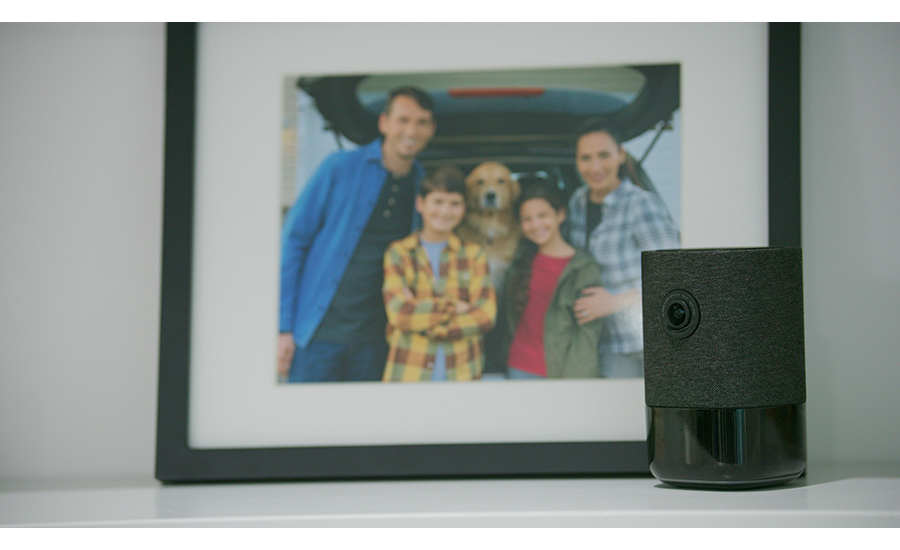
Families used Alarm.com’s Wellness and Wellcam products to stay in touch with loved ones in nursing homes during COVID-19. // IMAGE COURTESY OF ALARM.COM
And the exponential growth of IoT devices will only spur the growth of both smart home and security overall. “When you incorporate security and surveillance features in your smart home network, your home security can increase substantially,” Hess says. “There are tons of options here, but only a few dozen of which are currently being explored. Good example: home automation systems can connect motion detectors, surveillance cameras, automated door locks, and other tangible security measures throughout your home so you can activate them from one mobile device before heading out. You can also choose to receive security alerts on your various devices, depending on the time of day an alert goes off, and monitor activities in real time, whether you are in the house or halfway around the world.”
Integration of security and IoT devices is key in today’s smart security space, says Warren Hill, vice president of marketing, Alula, St. Paul, Minn. This includes traditional smart devices like lights, thermostats, and locks, as well as more recent entrants such as garage door controllers, voice-controlled virtual assistants, window coverings, fans, fireplaces, and more. “Panels that were being used only for intrusion detection and possibly life safety notifications can be turned into smart security systems with the addition of Z-Wave devices, cameras, a smart mobile app, and more,” he says. “Dealers and integrators want one-stop solutions that reliably meet the security, video, and automation demands of tech-savvy consumers.”
Video & Other Trends
Integral to this interconnectivity is the use of sophisticated AI-enhanced cameras, Hess says. “Security is a key trend in smart home device purchases, and as such, security cameras have been the leading volume driver for the past four years,” he says. “In fact, they made up nearly two out of every four smart home devices purchased from us in 2021, the most of any smart home product.”
These cameras, combined with video analytics technology, can differentiate between people, animals, and vehicles, and trigger outdoor lighting accordingly, says Ferguson of Alarm.com. She adds that 46 percent of the company’s new accounts created in Q4 2021 included video services.
Cameras and video services provide both security and convenience for customers. “A single security camera installed inside or outside of the home provides homeowners with an easy way to track package theft, deter break-ins, monitor suspicious activity, or simply check in on loved ones or even pets,” says Klein of Z-Wave. “Higher-quality video surveillance solutions that are capable of tracking disturbances as soon as they occur helped drive growth and will continue to impact the industry in 2022 and beyond.”
Security Professionals’ Perception of the Smart Home Market
SDM asked, “How would you rate the current state of the market and the potential for sales in the smart home/home entertainment system market?”
When asked about the state of the smart home/home entertainment market, 34 percent of security professionals surveyed for the Industry Forecast consider conditions to be very good or excellent, up 3 percentage points from the previous year. // SOURCE: SDM 2021 AND 2022 INDUSTRY FORECAST STUDIES
Increased camera use in security and smart home systems also offers more opportunities for security dealers, Parks Associates’ Hulla says. “For example, more and more security owners want external video feeds, with advanced analytics that can provide smarter alerts and reduce false alarms,” he says. “Professional installation ensures cameras are positioned correctly to enable these features.”
Matthew Robbins, vice president global product management-integrated home & building solutions at Resideo Technologies Inc., Scottsdale, Ariz., agrees. “I think we are just beginning to take advantage of cameras as an industry,” he says. “Cameras are the ideal sensor and there is more data richness that we can use to help our customers. Cameras are becoming synonymous with security in homeowners’ minds, and their expectations and willingness to invest are rising.”
So is the consumer’s desire to have cameras be monitored by dealer-owned or third-party central stations, says Woodie Andrawos, president, National Monitoring Center (NMC), Lake Forest, Calif. Video monitoring home systems also offer the opportunity for dealers to add to their recurring monthly revenue (RMR).
“The last two years have highlighted how important it is to create a recurring revenue stream and find ways to sell residential customers on other services, like PERS,” Andrawos says. “Our dealers were fortunate in that they were well equipped to consume predictable and consistent income during the pandemic. The value of home security was never more important than during quarantine because homeowners needed to ensure the security of their homes. More security and more effective monitoring of alarm panels was a necessity, and I forecast will continue to be in the future.”
Other emerging trends include a lean toward solar energy, with most of the big players in the industry, including Brinks Home, partnering with or acquiring solar energy companies, Sah says. “Including solar power along with a holistic smart home security system is a logical next step, and it will be exciting to see how these partnerships develop.”
While all of these trends point to ongoing growth in the security and smart home market, there are still some drawbacks to grapple with. Security dealers and manufacturers alike continue to struggle with the ongoing whack-a-mole game of shifting supply chain issues.
Current vs. Future Product/Service Offerings
SDM asked security dealers what products and services they offered now and plan to offer in the future. For smart home/home entertainment systems:
When asked about current and future plans to offer smart home systems, SDM 2022 Industry Forecast respondents indicated than nearly half currently sell them — up 11 percentage points over the previous year, while an additional 13 percent plan to start selling them in the next two years. // SOURCE: SDM 2021 AND 2022 INDUSTRY FORECAST STUDIES
“It’s a continuing trend; you can’t do a story about 2022 without talking about supply chain issues and inflation,” English says. “It’s definitely pressuring the success of 2022 after 2021. I wish it wasn’t the case, but it is. Our sales are strong, but it’s costing us 15 to 20 percent to deliver the same amount or additional revenue with the cost of metal and everything else; everybody in the industry has raised prices along the supply chain at one point or another. It’s not like we’re trying to make more money but trying to stave off cost increases to produce the same things we’ve been doing.”
And the fact that smart home technology is such a hot growth area means increased competition. “This space is getting a lot of attention and interest from not only small DIY players that are trying to grow, but also from Big Tech (Google’s investment in ADT, Amazon’s push to drive Ring adoption, etc.),” says Sah of Brinks Home. “This continued increase in competition will force the [dealers and integrators] or is already forcing them to up the game and be more responsive to shifting consumer needs.”
Top Residential Niches
SDM asked, “In which one residential market segment do you expect to see the highest rate of revenue growth in 2022?”
Existing middle-market homes top the list of residential segments 2022 SDM Industry Forecast respondents expect to see the highest revenue from this year. // SOURCE: SDM 2021 AND 2022 INDUSTRY FORECAST STUDIES
Another challenge is the lack of interoperability and compatibility between smart home functions. “Manufacturers do not like to talk about it, but incompatibility/compatibility is the biggest problem with smart home technology,” Hess says. “Installing many devices and platforms leads to the unfortunate realization that gadgets will not communicate with each other. For example, Amazon likes to design devices made for their proprietary platform like Echo or Alexa; therefore, the technology often will not work with non-native systems like Google Home and Apple.”
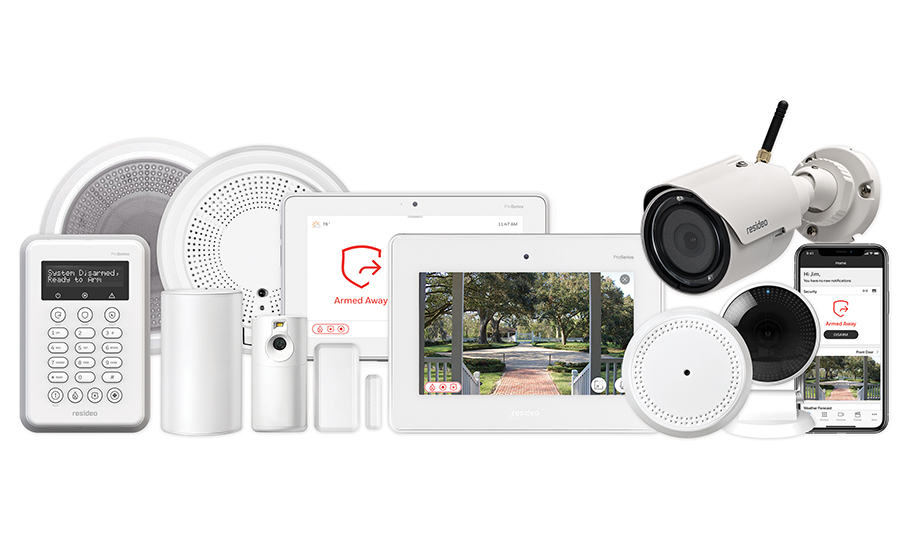
While some customers were concerned about installers in their homes at the beginning of COVID-19, the market rebounded quickly. // IMAGE COURTESY OF RESIDEO
Another big challenge is the security aspect of these devices, he adds. “Most all cloud-based gadgets are vulnerable to cyberattacks because many unsafely transmit data over the web, while most of these transmissions are not even relevant or necessary to the functionality of the installed IoT device,” Hess says. “IoT cloud devices can pose a security threat for homeowners since data, such as video data for cameras, are not encrypted when sent over the internet.”
DIY Installs
DIY installs saw a dramatic increase in market share from Q2 2020 to Q4 2021, driven by both improved DIY systems and fear of contracting COVID-19 from installation personnel. // SOURCE: PARKS ASSOCIATES
But in spite of the drawbacks, the electronic security industry will see growth in security and smart home sales as long as it focuses on the main reason for doing it: end user convenience and security.
“The more enhancements and information that can come from security and smart home systems, the more capabilities,” says George Brody, president, Telguard, Atlanta. “But we want to balance that with not being overwhelmed. Our basic platform or business is still protecting families, people, and property; that’s the core of what we do. We have a strong purpose in our business, and we’re doing great, our business is growing. But we all feel good about what we’re providing as far as a purpose behind the numbers.”

